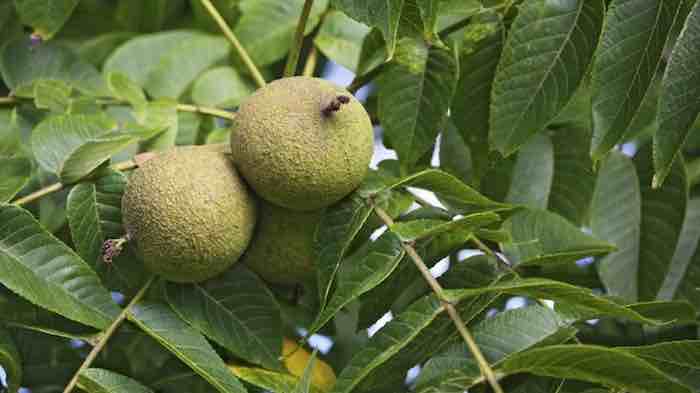
Walnut trees are wonderful -- so long as they aren't pounding people or their vehicles. Or preventing gardeners from growing prized plants in their proximity.
Roman naturalist Pliny the Elder knew all about this. "The shadow of walnut trees is poison to all plants within its compass, and it kills whatever it touches," he observed in his
Historia Naturalis.
His tree was
Juglans regia, variously known as the Common Walnut, Persian Walnut, and English Walnut but native from southeast Europe through to the Himalayas and China. The same toxicity is associated with
Juglans nigra, the Black Walnut of eastern and central North America.
The compound responsible for this chemical warfare is juglone, 5-hydroxy-1, 4-napthoquinone. This is non-toxic until oxidized by substances exuded by the roots of nearby plants. If these are sensitive the result is often fatal 'walnut wilt' that effects even the tree's own seedlings. It is also toxic to microorganisms, fungi, insects, fish, and even the occasional mammal.
Native peoples took advantage of this toxicity to utilize a leaf tea as an insecticide against bedbugs; an inner bark tea was drunk as laxative and emetic, the bark chewed for toothache. In more modern times, the dried leaves have been mixed with straw as a flea repellent in animal bedding.
Tomatoes, potatoes, asparagus and apples are all sensitive to juglone. Known ornamentals include azaleas and rhododendrons, chrysanthemums, honeysuckle, peonies, pines and roses.
However, turf grasses grow just fine close to walnut trees as do most ferns. Other resistant plants: beebalm, begonias, bellflowers, birches, forsythia, hollyhocks, hyacinths, marigolds, muscari, pansies, snowdrops, and Virginia creeper; blackberries and raspberries are said to positively flourish.
But allopathy exists in other plants too. For example, the roots of Sugar maple,
Acer saccharum, exert allelopathic effects on seedlings of yellow birch,
Betula alleghaniensis.
Other allopathy plants include asters, goldenrod, ragweed, hawkweed, tall buttercup, and crown vetch.
 Walnut trees are wonderful -- so long as they aren't pounding people or their vehicles. Or preventing gardeners from growing prized plants in their proximity.
Roman naturalist Pliny the Elder knew all about this. "The shadow of walnut trees is poison to all plants within its compass, and it kills whatever it touches," he observed in his Historia Naturalis.
Walnut trees are wonderful -- so long as they aren't pounding people or their vehicles. Or preventing gardeners from growing prized plants in their proximity.
Roman naturalist Pliny the Elder knew all about this. "The shadow of walnut trees is poison to all plants within its compass, and it kills whatever it touches," he observed in his Historia Naturalis.